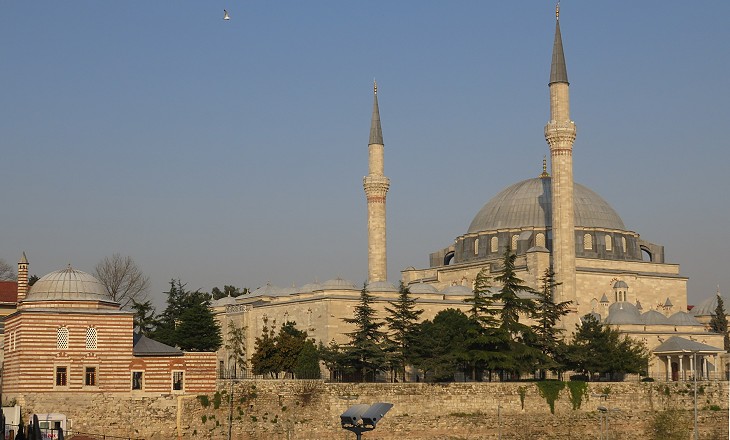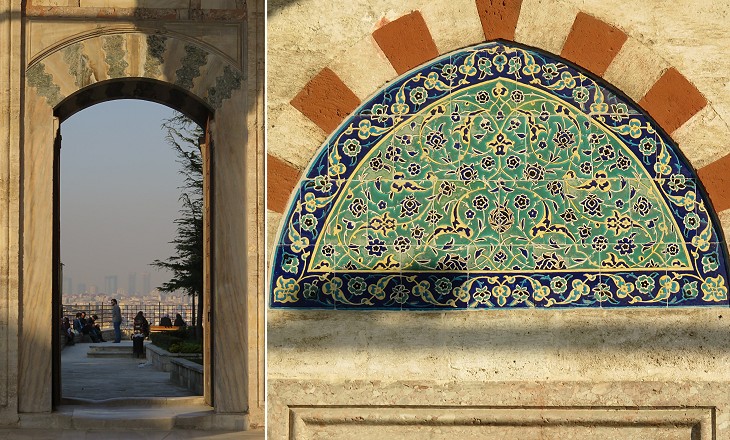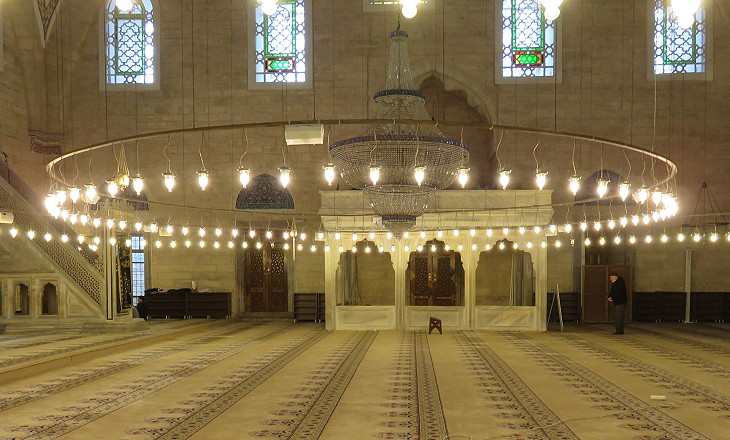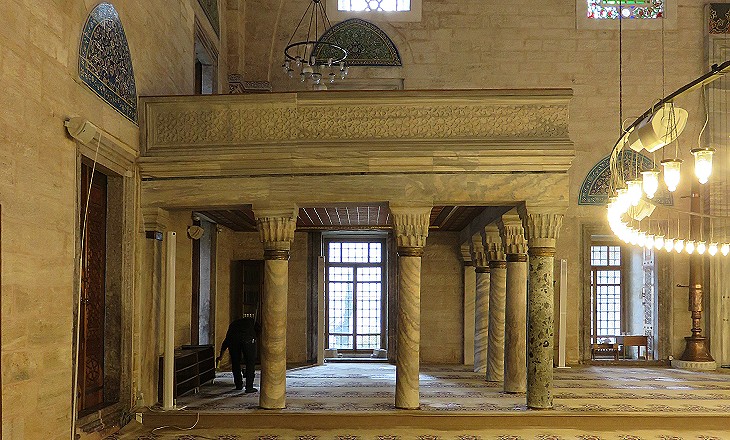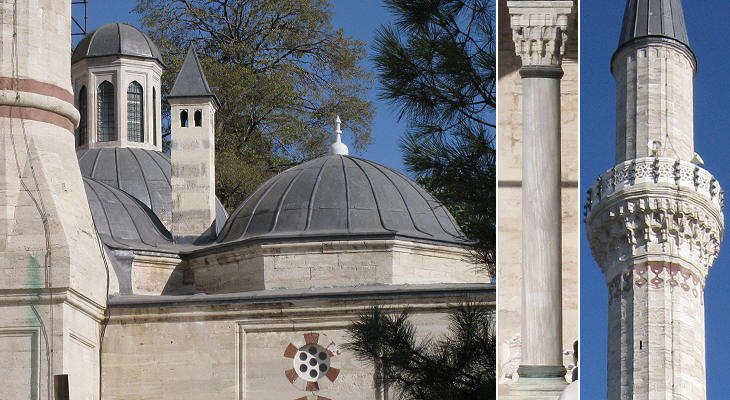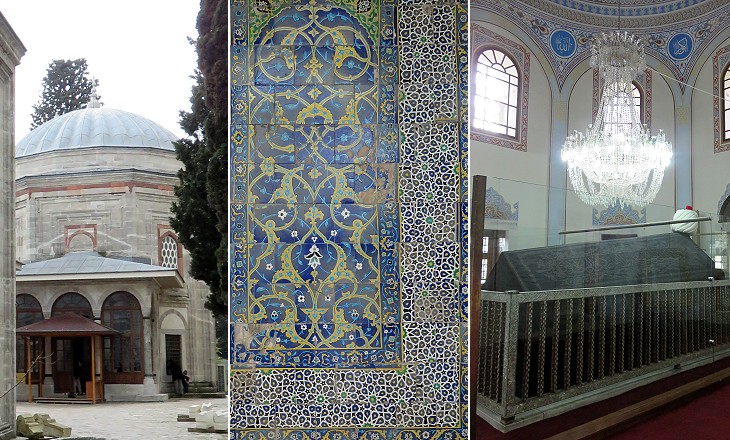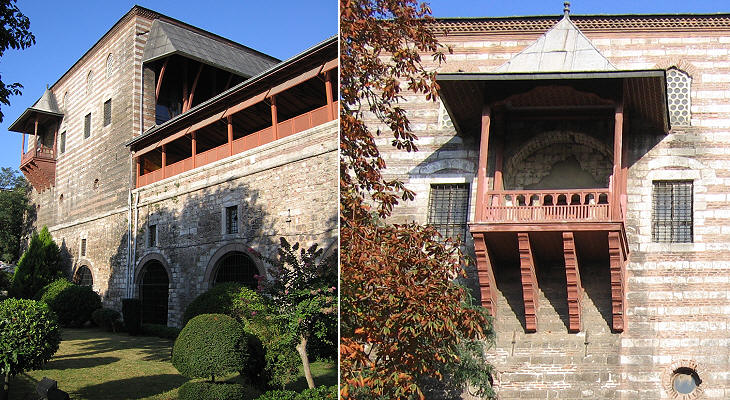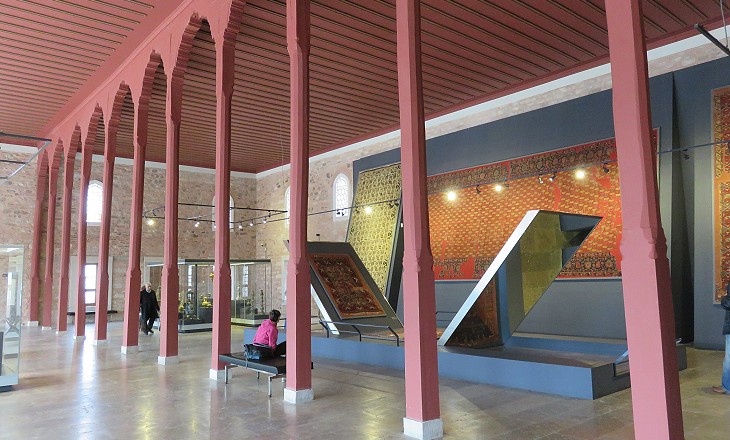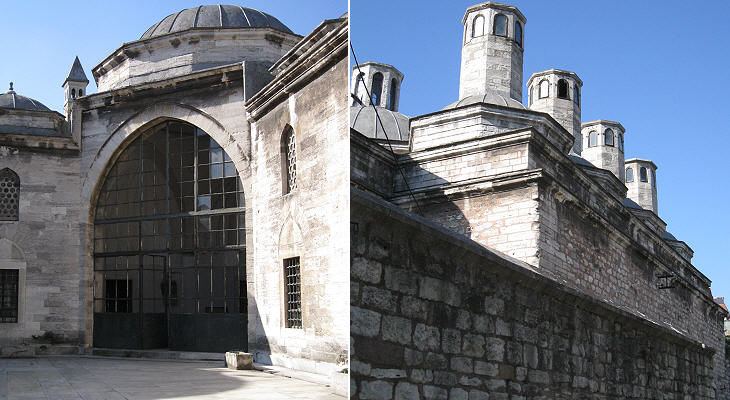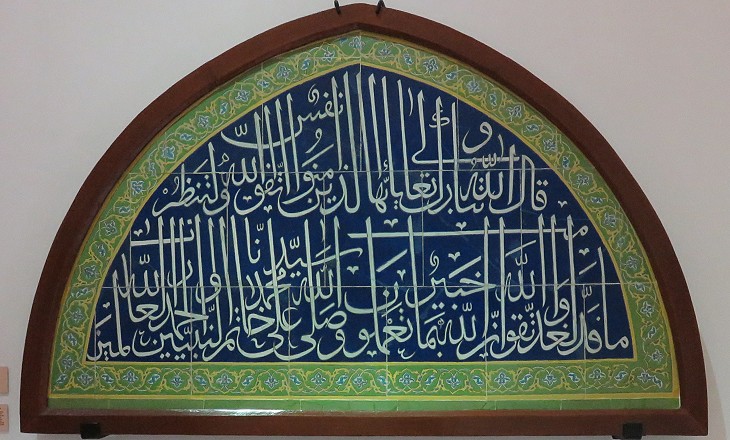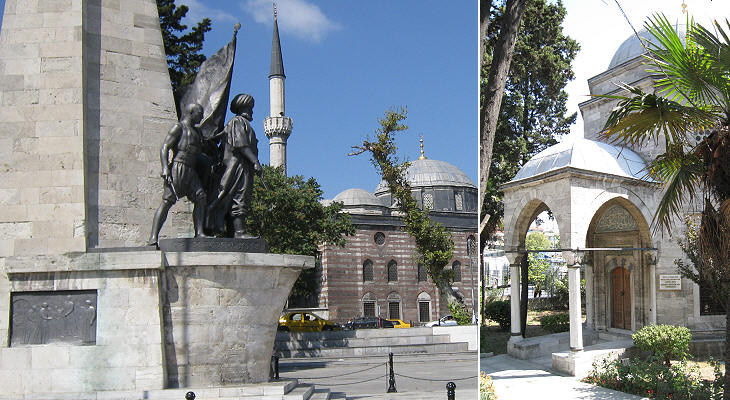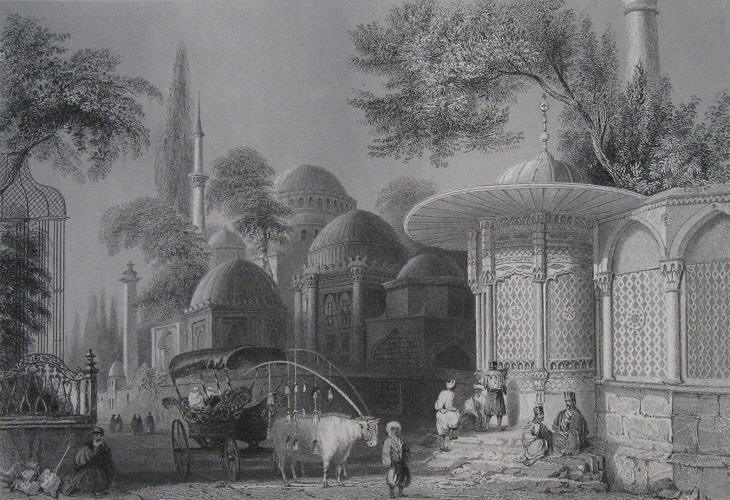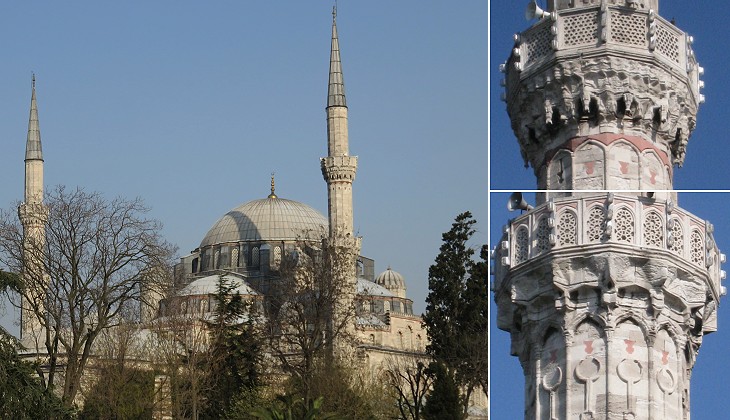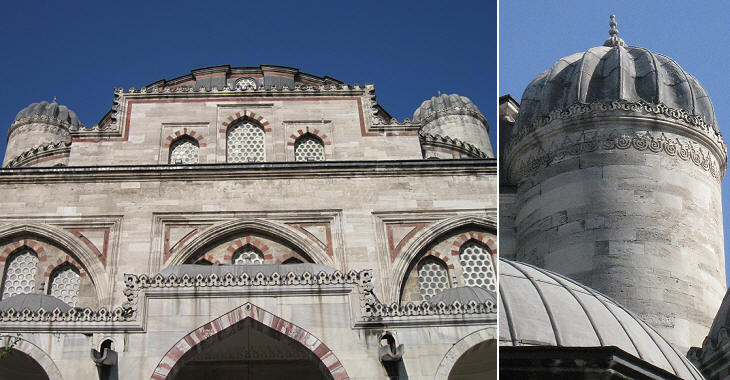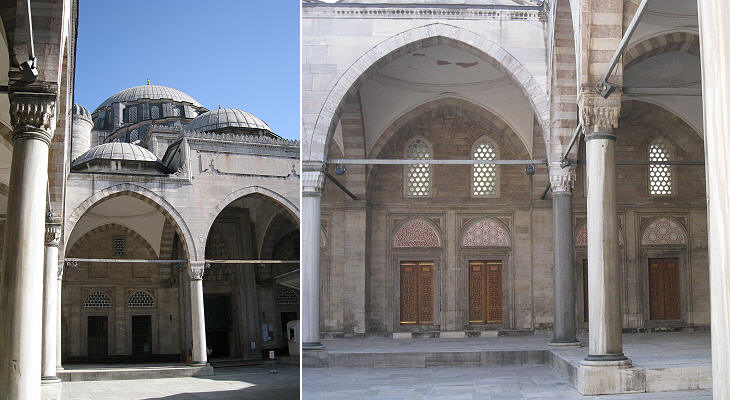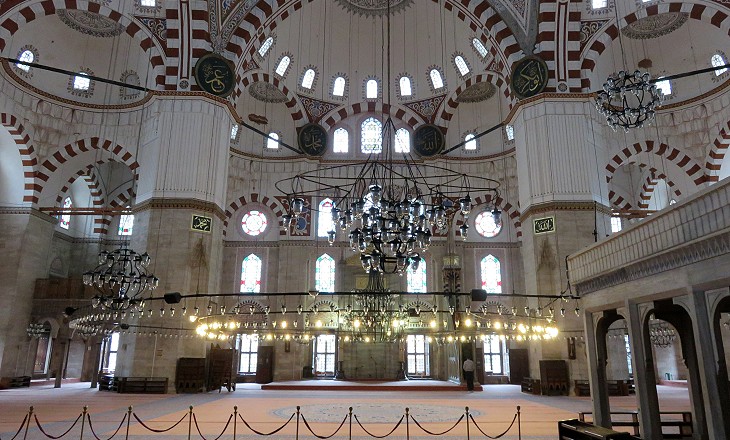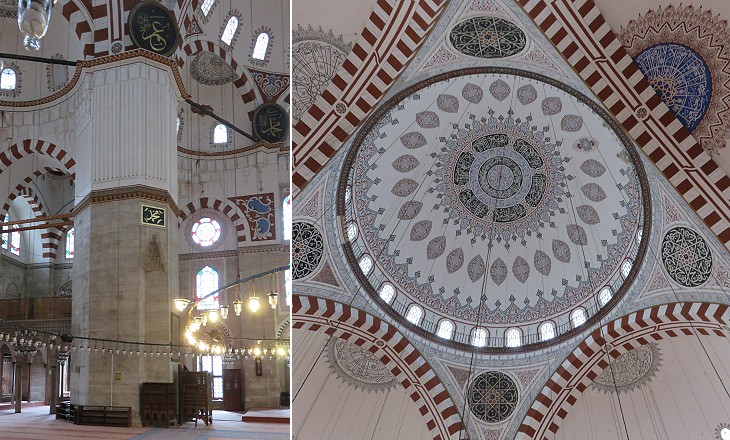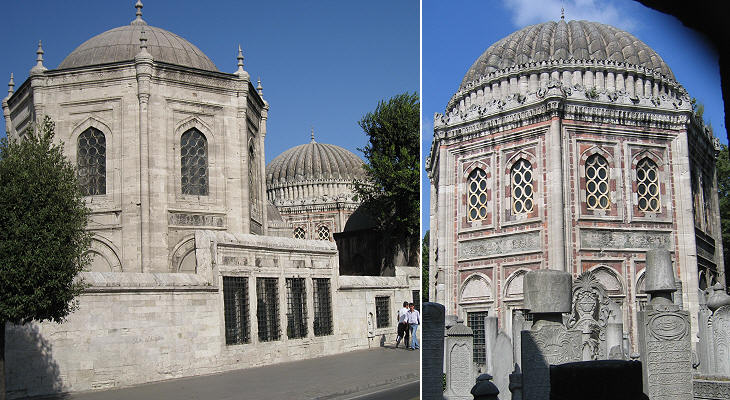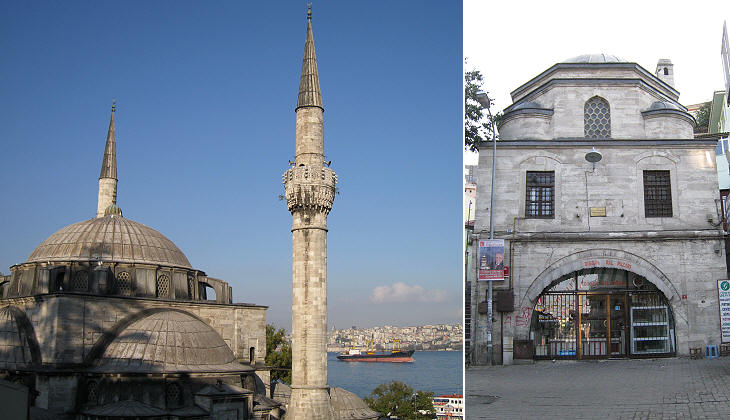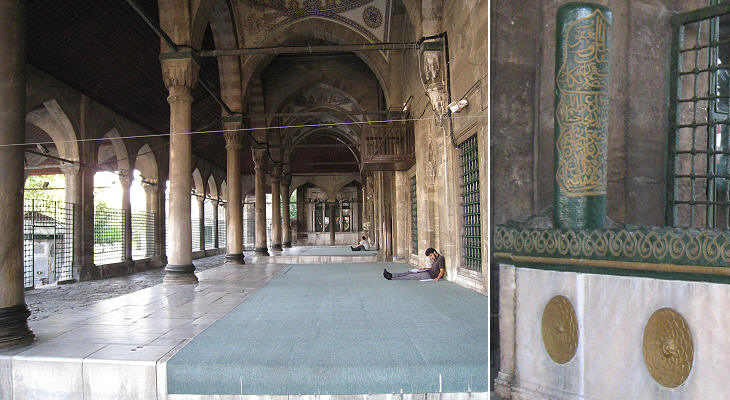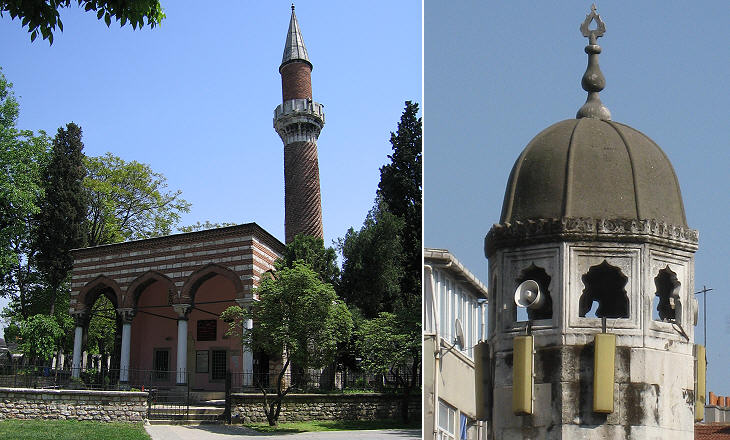  What's New! Detailed Sitemap All images © by Roberto Piperno, owner of the domain. Write to romapip@quipo.it. Text edited by Rosamie Moore. Page revised in August 2015. |
 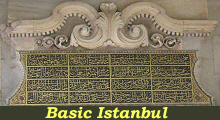 The Golden Century: I - from Selim I to Sinan The Golden Century: I - from Selim I to Sinan
You may wish to see an introduction to this section first. The last years of Sultan Beyazit II were marred by a fight for the succession among his sons. He had five adult sons whom he had appointed governors of a province. Ahmet, the eldest, was well liked by the people and had proved to be a capable administrator, but was regarded as a weak commander by the Janissaries, the Úlite corps. Korkut enjoyed the favour of the ulema, the Muslim religious leaders. Selim had acquired a reputation for being hard and pitiless, but was supported by the Janissaries and by the border province governors. Two other sons Sehinsah and Alemsah died before their father. The three remaining brothers manoeuvred in order to become the next sultan, but while the first two tried to convince their father to choose them, Selim sought the help of the Janissaries and eventually challenged the power of Beyazit by marching towards Constantinople with an army of Crimean Tatars. The Janissaries forced Beyazit to abdicate in favour of Selim (April 1512); a few days later the old sultan died. Selim tried to appease his brothers by confirming their governorships, but without success; in a few months he eliminated their challenge to the throne by having them killed together with their offspring.
Selim is remembered as Yavuz (the Brave/the Stern) because of the military campaigns he led by which Syria, Palestine and Egypt were annexed to the Ottoman Empire. He is also remembered as the Cruel because of a traditional account which says that he ordered the killing of his own sons with the exception of one, Suleyman who accompanied him on his campaigns. The execution of princes, grand viziers and other people of high rank were usually done by strangling them with the string of a bow. Similar to his predecessors Selim built a large kulliye which was finished in 1522 by his heir Sultan Suleyman.
The kulliye was built on the top of the Fifth Hill and on the edge of the Cistern of Aspar. The terrace on the northern side of the mosque commands a grand view over the Golden Horn and over Suleymaniye Kulliyesi. The choice of the colours of the stones and tiles used for the decoration of the buildings was excellent.
The plan of the prayer hall is pretty simple as it consists of a large square room with a high dome which rests on the outer walls. There are no pillars or side aisles as in many of the large mosques which were built in the following years. Without them the prayer hall looks bare.
The choice of the marbles of the Sultan's lodge are another indication of the refined tastes of the kulliye architect. He chose to use mainly Proconnesian marble, quarried on an island of the Sea of Marmara, which is white with greyish stripes and to add a bit of colour by placing an ancient vert antique column on the corner of the small building.
It is thought that the complex was designed by a Persian architect taken to Constantinople as a slave after Selim conquered Tabriz in southern Azerbaijan. The prayer hall and the courtyard were decorated with tiles from Iznik (Nicaea) where Selim relocated skilled ceramists from Tabriz.
Selim added to the titles he received from his predecessors that of Custodian of the Two Holy Mosques (of Mecca and Medina), a very prestigious one in the Muslim world. In 1986 the title was assumed by Fahd bin Abdul Aziz, King of Saudi Arabia.
Suleyman became sultan in 1520 and he continued the expansionist policies of his father; Selim had died while preparing an expedition against the Knights of Rhodes and Suleyman brought it to a successful end in 1522 when the Grand Master surrendered the city of Rhodes and the other fortresses of the Knights in Kos and Bodrum. Suleyman appointed Grand Vizier Pargali Ibrahim Pacha, a friend from his youth; Ibrahim was born at Parga and at the age of six was sent as a slave to the Ottoman court where he was befriended by young Suleyman; he then became his falconer and when his master decided to get rid of the Grand Vizier named by his father, the choice fell on Ibrahim. He became part of the Imperial family by marrying one of Suleyman's sisters. Many grand viziers had been executed by their masters, to the point that one of them asked the sultan (Selim) to be given some notice so that he could arrange his personal affairs. Suleyman solemnly promised Ibrahim he would not kill him during his reign and yet in 1536 Ibrahim was executed, probably instigated by Roxelana, Suleyman's wife who had great influence over her husband.
Ibrahim built a large palace on the western side of the ancient Hippodrome, a choice which some see as due to his Greek origin. His palace was not inferior to that of Suleyman and after his death it became the residence of grand viziers, admirals and other high officers of the Ottoman court. It now houses the Museum of Turkish and Islamic Arts (you may wish to see a Safavid beggar's bowl - it opens in another window).
One could say, by making a parallel with Papal Rome (*), that during the XVIth century the Ottoman Empire passed from the influence of Mars to that of Venus to indicate the growing influence of sultan's wives on state affairs and the end of expansionist policies. A large kulliye was built in 1538-39 by Haseki Hurrem, Suleyman's wife, known in Europe as Roxelana, after her Russian (actually Ukrainian) origin. Haseki means "sultan's wife who bore him a son", while Hurrem was her Muslim name ("the cheerful one"). It is a large complex where the facilities for the poor are more interesting than the mosque.
Haseki Hurrem Kulliyesi is important from a historical viewpoint because it is the first large building of Ottoman Constantinople which was named after a woman and because it was the first which was designed by Mimar Sinan, the greatest Ottoman architect.
Sinan was born near Kayseri into a Christian family; when Sultan Selim conquered the region he implemented the devsirme and Sinan (this is the Muslim name he was given) was recruited by the Janissaries, although he was already a young man. He fought and rose in the military until he was given the task of supervising engineering activities: he then became the supervisor of all constructions commissioned by the Ottoman court. One of his first works was the construction of a small, but elegant turbe for Hayreddin Barbarossa, a popular hero among the Ottomans and the terror of the Christians living on the Mediterranean shores. With Barbarossa's help the Ottoman Empire expanded its possessions to Algeria. For many years he raided the coasts of Spain, France and Italy. He was then appointed chief admiral of the Ottoman navy and took part in the first (failed) siege of Corfu in 1537 and in the Battle of Preveza in 1538 where he defeated a large Christian fleet. He eventually retired to Istanbul where he lived in a palace overlooking the Bosporus.
Sultan Suleyman was not particularly interested in architecture nor in associating his name with a large building as his predecessors had done: the grief over the death of one of his sons changed his mind. Sehzade means prince and Sehzade Camii is the mosque Suleyman built in memory of his son Mehmet (the correct name should be Sehzade Mehmet Camii, but usually the prince's name is omitted).
Sinan was commissioned the construction of Sehzade Camii; the result pleased Suleyman and the other members of the family so much that in the next years they all started commissioning him new buildings. In Sehzade Camii Sinan built a large central dome surrounded by four semi-domes: the strength of the construction was enhanced by four turrets above the roof level. It is situated on the Third Hill, but not at its highest point; a few years later that location was chosen by Suleyman for his own mosque.
Mehmet was the first son Hurrem bore to Suleyman, but not the eldest one of the sultan; it is uncertain whether Suleyman considered Mehmet his heir, because Mustafa, a son he had from a concubine, was appointed governor of Amasya, a position traditionally reserved to the sultan's heir. Mehmet died of smallpox in 1543 at the age of 22, when he was governor of Manisa. The tradition was that princes were to be buried at Bursa, the first capital of the Ottomans, but Suleyman chose to bury his son in Constantinople as if he had been a sultan.
A very imposing courtyard precedes the entrance to the mosque; the four porticoes are of an unusual height and depth; this design in part reduces the dome visibility.
The turrets on the outside are the ends of four gigantic pillars supporting the dome. In a church their heavy presence could have been made lighter by using stuccoes or painting or statues (similar to what Gian Lorenzo Bernini did in Rome), but these tools were not available to Sinan.
Sinan tackled the issue by designing a small niche in the pillars and by making them slightly irregular in shape. In later works he chose to partially include the pillars in side walls, rather than leaving them free-standing. The view of the ceiling gains from the presence of the four semi-domes and from the relatively high windows of the drum.
Sehzade Mehmet was buried in a turbe (designed by Sinan) behind the mosque; later on other turbe were built near the first one, including that of Damat Ibrahim Pacha. Of particular interest is the use of ribbed domes in Sehzade's turbe and in the turrets of the mosque. They were not part of the Ottoman tradition, but they were often employed in the architecture of Central Asia, chiefly in Samarkand.
A second woman who influenced Suleyman's decisions was his daughter Mihrimah; she was born in 1522 and she was the only daughter Hurrem bore to Suleyman. She was married to Rustem Pacha, a member of Suleyman's inner circle who was appointed Grand Vizier a few years after the marriage. Mihrimah commissioned Sinan a kulliye which is also known as Iskele (port) kulliye because it was built near the boat landing at Uskudar, at the Asian southern entrance to the Bosporus.
The mosque is the first of two built by Sinan for Mihrimah; the second one was built near the walls at Edirne Kapi and it is known for a design which allows a lot of light in the prayer hall; this probably because there is not much light inside the mosque at Uskudar. An interesting feature of Mihrimah Camii is its double portico, which Sinan used in other later buildings.
Burmali Camii is one of the very few mosques of this period which was not designed by Sinan; this probably because it was not commissioned by the sultan or by a member of his families or of the court, but by an Egyptian Kadi (judge), Emin Nurettin Osman. This may explain the design of its spiralling (burmali) minaret which is a smaller replica of a famous one which already existed at Edirne (Uc Serefeli Camii). Sinan is regarded as the Michelangelo of Ottoman architecture, but unlike his contemporary Florentine colleague, he could not impose his will on those for whom he worked: he had to seek their endorsement for his projects. Although he gained their trust he had to be careful not to seem to forgo their views. He probably had in mind some revolutionary ideas for the design of minarets, but he was able to put them in practice only in a mescit (small mosque) which he built at his personal expense. (*) During the celebrations which followed the election of Pope Leo X a temporary inscription said: First Venus (i.e. Pope Alexander VI) ruled, then it was the time of Mars (Pope Julius II), now the sceptre is in the hands of Minerva. Introduction to this section Roman Memories Hagia Sophia Hagia Irene and Little Hagia Sophia Roman/Byzantine exhibits at the Archaeological Museum Great Palace Mosaic Museum Byzantine Heritage - Other Churches (before 1204) St. Saviour in Chora Byzantine Heritage (between 1204 and 1453) First Ottoman Buildings The Golden Century: II - The Age of Suleyman The Golden Century: III - Suleymaniye Kulliye The Golden Century: IV - Sinan's Last Works The Heirs of Sinan Towards the Tulip Era Baroque Istanbul The End of the Ottoman Empire Topkapi Sarayi Museums near Topkapi Sarayi The Princes' Islands Map of Istanbul Other pages dealing with Constantinople/Istanbul: The Walls of Nova Roma Galata Clickable Map of Turkey showing all the locations covered in this website (opens in another window). |
